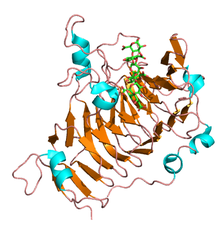Pectinesterase
| pectinesterase | |||||||||
|---|---|---|---|---|---|---|---|---|---|

|
|||||||||
| Identifiers | |||||||||
| EC number | 3.1.1.11 | ||||||||
| CAS number | 9025-98-3 | ||||||||
| Databases | |||||||||
| IntEnz | IntEnz view | ||||||||
| BRENDA | BRENDA entry | ||||||||
| ExPASy | NiceZyme view | ||||||||
| KEGG | KEGG entry | ||||||||
| MetaCyc | metabolic pathway | ||||||||
| PRIAM | profile | ||||||||
| PDB structures | RCSB PDB PDBe PDBsum | ||||||||
| Gene Ontology | AmiGO / EGO | ||||||||
|
|||||||||
| Search | |
|---|---|
| PMC | articles |
| PubMed | articles |
| NCBI | proteins |
| Pectinesterase, catalytic | |||||||||
|---|---|---|---|---|---|---|---|---|---|
| Identifiers | |||||||||
| Symbol | Pectinesterase_cat | ||||||||
| Pfam | PF01095 | ||||||||
| InterPro | IPR000070 | ||||||||
| PROSITE | PDOC00413 | ||||||||
|
|||||||||
| Available protein structures: | |
|---|---|
| Pfam | structures |
| PDB | RCSB PDB; PDBe; PDBj |
| PDBsum | structure summary |
Pectinesterase (PE) (EC 3.1.1.11) is a ubiquitous cell-wall-associated enzyme that presents several isoforms that facilitate plant cell wall modification and subsequent breakdown. It is found in all higher plants as well as in some bacteria and fungi. Pectinesterase functions primarily by altering the localised pH of the cell wall resulting in alterations in cell wall integrity.
Pectinesterase catalyses the de-esterification of pectin into pectate and methanol. Pectin is one of the main components of the plant cell wall. In plants, pectinesterase plays an important role in cell wall metabolism during fruit ripening. In plant bacterial pathogens such as Erwinia carotovora and in fungal pathogens such as Aspergillus niger, pectinesterase is involved in maceration and soft-rotting of plant tissue. Plant pectinesterases are regulated by pectinesterase inhibitors, which are ineffective against microbial enzymes.
Recent studies have shown that the manipulation of pectinesterase expression can influence numerous physiological processes. In plants, pectinesterase plays a role in the modulation of cell wall mechanical stability during fruit ripening, cell wall extension during pollen germination and pollen tube growth, abscission, stem elongation, tuber yield and root development. Pectinesterase has also been shown to play a role in a plants response to pathogen attack. A cell wall-associated pectinesterase of Nicotiana tabacum is involved in host cell receptor recognition for the tobacco mosaic virus movement protein and it has been shown that this interaction is required for cell-to-cell translocation of the virus.
...
Wikipedia
